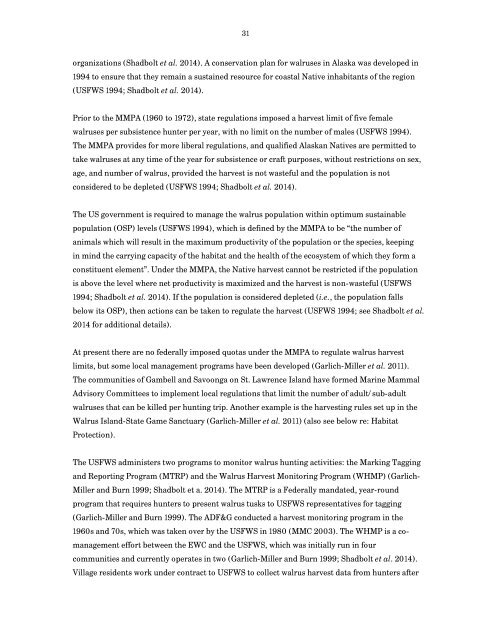The State of Circumpolar Walrus Populations
walrusreport
walrusreport
You also want an ePaper? Increase the reach of your titles
YUMPU automatically turns print PDFs into web optimized ePapers that Google loves.
31<br />
organizations (Shadbolt et al. 2014). A conservation plan for walruses in Alaska was developed in<br />
1994 to ensure that they remain a sustained resource for coastal Native inhabitants <strong>of</strong> the region<br />
(USFWS 1994; Shadbolt et al. 2014).<br />
Prior to the MMPA (1960 to 1972), state regulations imposed a harvest limit <strong>of</strong> five female<br />
walruses per subsistence hunter per year, with no limit on the number <strong>of</strong> males (USFWS 1994).<br />
<strong>The</strong> MMPA provides for more liberal regulations, and qualified Alaskan Natives are permitted to<br />
take walruses at any time <strong>of</strong> the year for subsistence or craft purposes, without restrictions on sex,<br />
age, and number <strong>of</strong> walrus, provided the harvest is not wasteful and the population is not<br />
considered to be depleted (USFWS 1994; Shadbolt et al. 2014).<br />
<strong>The</strong> US government is required to manage the walrus population within optimum sustainable<br />
population (OSP) levels (USFWS 1994), which is defined by the MMPA to be “the number <strong>of</strong><br />
animals which will result in the maximum productivity <strong>of</strong> the population or the species, keeping<br />
in mind the carrying capacity <strong>of</strong> the habitat and the health <strong>of</strong> the ecosystem <strong>of</strong> which they form a<br />
constituent element”. Under the MMPA, the Native harvest cannot be restricted if the population<br />
is above the level where net productivity is maximized and the harvest is non-wasteful (USFWS<br />
1994; Shadbolt et al. 2014). If the population is considered depleted (i.e., the population falls<br />
below its OSP), then actions can be taken to regulate the harvest (USFWS 1994; see Shadbolt et al.<br />
2014 for additional details).<br />
At present there are no federally imposed quotas under the MMPA to regulate walrus harvest<br />
limits, but some local management programs have been developed (Garlich-Miller et al. 2011).<br />
<strong>The</strong> communities <strong>of</strong> Gambell and Savoonga on St. Lawrence Island have formed Marine Mammal<br />
Advisory Committees to implement local regulations that limit the number <strong>of</strong> adult/sub-adult<br />
walruses that can be killed per hunting trip. Another example is the harvesting rules set up in the<br />
<strong>Walrus</strong> Island-<strong>State</strong> Game Sanctuary (Garlich-Miller et al. 2011) (also see below re: Habitat<br />
Protection).<br />
<strong>The</strong> USFWS administers two programs to monitor walrus hunting activities: the Marking Tagging<br />
and Reporting Program (MTRP) and the <strong>Walrus</strong> Harvest Monitoring Program (WHMP) (Garlich-<br />
Miller and Burn 1999; Shadbolt et a. 2014). <strong>The</strong> MTRP is a Federally mandated, year-round<br />
program that requires hunters to present walrus tusks to USFWS representatives for tagging<br />
(Garlich-Miller and Burn 1999). <strong>The</strong> ADF&G conducted a harvest monitoring program in the<br />
1960s and 70s, which was taken over by the USFWS in 1980 (MMC 2003). <strong>The</strong> WHMP is a comanagement<br />
effort between the EWC and the USFWS, which was initially run in four<br />
communities and currently operates in two (Garlich-Miller and Burn 1999; Shadbolt et al. 2014).<br />
Village residents work under contract to USFWS to collect walrus harvest data from hunters after


